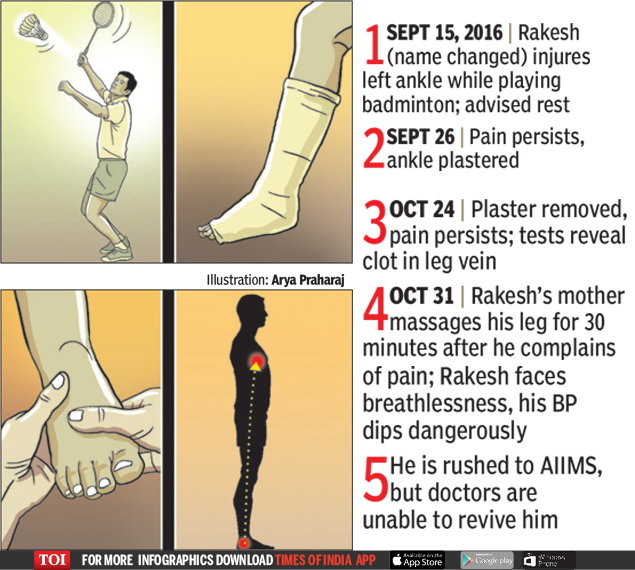The victim, a resident of Delhi, had injured his left ankle while playing badminton last year after which a plaster of Paris slab was placed on it to immobilise the leg. This resulted in the formation of a blood clot in his deep veins. A postmortem confirmed that the clot, which was 5X1cm in size, got dislodged from the leg veins and travelled to the pulmonary artery that supplies blood to the lungs, causing instant death.
Deep vein thrombosis or presence of a blood clot in the deep veins following an ankle fracture is not uncommon but sudden death of a youth because of the complications arising from it is rare, said Dr Chittaranjan Behera, who conducted the postmortem on him.
The doctor said when the 23-year-old was rushed to AIIMS emergency at 9.30pm on October 31 he was unconscious and unresponsive. “Doctors could not revive him despite the best resuscitative efforts. Later, it was found that the victim’s mother had given him a massage for 30 minutes and he complained of pain in the left calf at around 8.45pm. That left him breathless and he suddenly collapsed. This was because the clot in his leg travelled to the arteries that supply blood to the lungs,” Dr Behera explained.

The youth’s case report was published in the latest issue of Medico-Legal Journal. It stated that massages are often given for general fitness and for treating minor health problems. “In this case, the deceased’s mother had massaged the leg to alleviate pain and was unaware of the complications. There was no advice recorded in the hospital by the doctors about the risks and dangers of a massage to this affected leg. This advice should have been provided,” it added.
Dr Sudhir Gupta, professor and head of forensic medicine at AIIMS, said the youth’s death should serve as a warning against massages by amateurs. “Using forceful techniques and for prolonged periods in a patient with deep vein thrombosis can lead to fatal complications,” he said.
Presence of a blood clot in the deep veins of the leg or the pulmonary artery affects nearly 70 per 1,00,000 individuals, according to AIIMS doctors. It is common in patients with skeletal trauma and immobilisation. But deep vein thrombosis is also seen in the elderly, obese, smokers, those who use contraceptives quite often and people suffering from Chronic Obstructive Pulmonary Disease.
No comments:
Post a Comment